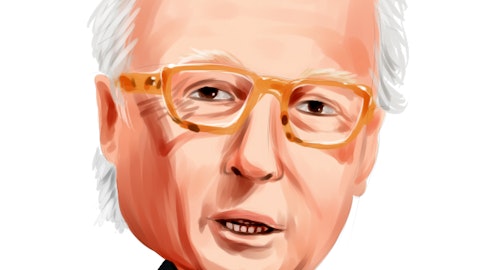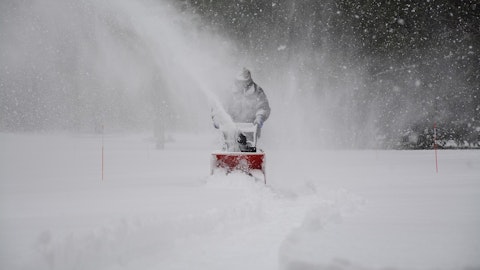BrightView Holdings, Inc. (NYSE:BV) Q1 2023 Earnings Call Transcript February 7, 2023
Operator: Good morning, and a warm welcome to the BrightView First Quarter Fiscal Year 2023 Earnings Conference Call. My name is Candice, and I will be your operator for today’s call. I would now like to hand you over to our host, Faten Freiha, Vice President of Investor Relations. Please go ahead.
Faten Freiha: Good morning. Thank you for joining BrightView’s first quarter fiscal 2023 earnings conference call. Andrew Masterman, Chief Executive Officer; and Brett Urban, Chief Financial Officer, are on the call. Please remember that some of the comments made today, including responses to questions and information reflected on the presentation slides are forward-looking and actual results may differ materially from those projected. Please refer to the company’s SEC filings for more detail on the risks and uncertainties that could impact the company’s future operating results and financial condition. Comments made today will also include a discussion of certain non-GAAP financial measures. Reconciliations to comparable GAAP financial measures are provided in today’s press release.
Disclaimers on forward-looking statements and non-GAAP financial measures apply both to today’s prepared remarks as well as the Q&A. I’ll now turn the call over to BrightView’s CEO, Andrew Masterman.
Andrew Masterman: Good morning, and thank you all for joining us today. We are pleased to start fiscal 2023 with a strong first quarter underpinned by robust organic growth, acquisition benefits, disciplined cost management and a steadfast focus on executing our growth strategy to continue to drive momentum in our business. We delivered seventh consecutive quarter of land organic growth, and we grew our annual snow contracts in the mid-single digits. And our development business continued to deliver excellent organic growth. From a profitability standpoint, adjusted EBITDA exceeded the high end of our guidance, driven by the strength of our top line, pricing efforts, improved operating performance and disciplined cost management.
Investments we made over the last few years in our sales force and technology are driving the strength and durability of our top line results, and these benefits are being realized in our profitability. Our priority is clear. We will continue to execute on our strategic plan to deliver solid organic growth, focusing on elements we can control, while implementing initiatives to mitigate against externally driven headwinds and improve profitability. Looking into fiscal year 2023, I would like to emphasize my conviction that despite the low snowfall, we intend to deliver strong organic growth and margin expansion in both our land and development businesses. Let me begin by reviewing the highlights for the first quarter on Slide 4. Revenue performance was supported by robust organic growth across maintenance and development as well as accretive M&A transactions.
Land organic growth of 1.5% was driven by new sales growth, stabilized retention rates and ancillary growth. We benefited from additional hurricane cleanup revenue in the Fort Myers area, which was offset by significant rain across our coastal markets impacting ancillary installations. Our snow services business consists of annual contracts and our results vary based on actual snowfall realization. In Q1, our snow services revenue grew by 50% organically relative to the prior year, reflecting 6% growth in annual contracts and 44% in snow volume realization. It’s important to note that in the prior year, we experienced significantly below average snowfall. Even with this quarter’s growth, snowfall was about 15% below historical averages in our footprint for Q1 of fiscal 2023.
The Development segment delivered 5.9% organic growth this quarter, underscoring a clear momentum in the business. Our team is working hard on expanding our customer base. And as a result, our backlog is extremely robust. Adjusted EBITDA for the quarter was $49 million, significantly above the high end of our guidance range of $44 million, driven by organic growth, pricing benefits as well as continued recovery in our development margins. Adjusted EBITDA certainly benefited from a snow increase. However, margin flow-through was lower than expected due to significantly below average snowfall in the Northeast and the Mid-Atlantic. Total consolidated adjusted EBITDA margin of 7.4%, reflects 20 basis points year-over-year improvement, underscoring our focus on profitability and supporting our long-term expectations of improving margins over time.
From a balance sheet perspective, we entered into hedge agreements that effectively fixed interest rates on 70% of our total current debt or approximately $1 billion. Through these agreements, we kept our exposure to interest rate headwinds and structured a hedge that enables us to benefit with rates decline. Brett will have more details in his remarks about our debt management. And importantly, we remain disciplined stewards of capital and continue to manage capital expenditures prioritize select accretive acquisitions and target improving our leverage ratio through EBITDA growth. Before I get into a strategic update on the business, let’s turn to Slide 5 to review snowfall data, the largest variable to our results for the first and second quarters.
On the left-hand side, the slide showcases snowfall averages in our top three markets for the first quarter versus the prior year. As you can see, Denver snowfall came in above historical averages. While at the same time, snowball in Chicago and Boston were significantly below average. Across our footprint for the first quarter, snowfall was at 85% of the 30-year average compared to the 30% in the prior year. We experienced snowfall in the Midwest and Pacific Northwest. However, we saw little to no snow events in the Northeast and Mid-Atlantic, our two largest regions with higher levels of self-performance and margins. Therefore, while our top line benefited from snow removal services, the benefit to our adjusted EBITDA was lower than expected.
As we have noted in the past, snow margin is driven by many factors, including when, where, how much and how often it snows and will change every year. Looking ahead to Q2, it’s prudent to call out that snowfall totals in January of 2023 are significantly below historical averages, particularly on the East Coast, which represents 60% of our total snow business. As you can see, snowball averages in January across our total footprint are down from the prior year. Furthermore, the elevated temperatures indicated that snow levels will likely remain low. As a result, we are guiding to a second quarter adjusted EBITDA range with the snow expectation that reflects this reality. Brett will provide the detailed guidance in his remarks. Let’s move to Slide 6 to review our top line growth drivers, which remain unchanged.
Our sales force is driving strong sales growth across our entire business. Their consistent execution drives the confidence behind our expectation for robust organic growth in fiscal year 2023. We continue to see solid customer demand in our contract-based business, ancillary penetration remains high, and our development pipeline remains robust. Importantly, we are not seeing any indications of a slowdown in our landscaping markets. On the technology front, our digital innovation across a number of platforms has helped drive net new growth, and it is one of the reasons we continue to enjoy organic growth that exceed industry rates. Our initiatives around digital implementation tools have a time horizon of several years as we continue to roll out enhancements based on customer feedback.
Our streamlined customer engagement tool, BV Connect, enables us to continue to transform the industry and our business into a more digital and future-focused organization. Furthermore, our integrated suite of applications drives efficiency, seamless acquisition integration and robust data analytics. The net result being superior operational efficiencies with better service quality and safety over time, technology investments will drive enhanced customer engagement and retention as well as team member engagement. Let’s turn to Slide 7 to discuss our strategic M&A, which remains a key growth pillar. Our acquisition strategy is focused on increasing our density and leadership positions in existing local markets, entering attractive new geographic markets, expanding our portfolio of landscape enhancement services and improving technical capabilities in specialized services.
Most recently, we completed our acquisition of Smith’s Tree Care, a leading service provider based in Newport News, Virginia. In addition, we acquired Island Plant Company, or IPC, a leading commercial landscaping provider on the island of Maui and Hawaii. With IPC, we have further expanded our presence and strengthened our leadership position in this very attractive market. We believe BrightView is now the leading landscaping provider in Hawaii. In addition to the Hawaii market over the last two years, through attractive and accretive M&A deals, we have meaningfully expanded our presence and build a strong leadership position in Minnesota and Boise, Idaho to excellent high-growth MSAs. As we have said on our last call, we are focused on select strategic transactions at very attractive valuations that will add significant shareholder value over time.
Importantly, our M&A pipeline remains robust, with more than $700 million of opportunity, enabling us to continue to execute on our expansion strategy and deliver robust free cash flow over time. Let’s now move to Slide 8 to discuss our cost structure. We continue to take a disciplined and strategic approach to managing our costs as evidenced by our margin expansion in the first quarter. While we have seen strong top line growth in our business over the last two years, total profitability has been impacted by a number of externally driven factors, including variability in our snow business, historically high inflation rates and most recently, a spike in fuel prices. We are determined and focused on managing through these headwinds to enhance our profitability and better position the company for the long-term.
And we have taken measures in each of our business segments to enhance and improve our profitability and – help offset these headwinds. In our land maintenance business over the last couple of years, wage rates and material costs have risen significantly. Through our pricing initiatives, which we began implementing in the second half of last year, we succeeded in offsetting these increases. In recent quarters, the pricing benefits we realized were masked by the unexpected spike in fuel costs. We took a balanced approach with customers, absorbed some of the incremental fuel costs while focusing on strategic pricing initiatives, improving ancillary penetration and attracting larger and more profitable clients. While the spike in fuel has subsided, we remain diligent in balancing customer relationships, fuel surcharges and market dynamics.
Turning now to our snow business, while this business is highly reliant on a mount and geography of snowfall, our goal remains to improve and stabilize the margin profile over time. As we have said in the past, we began the expansion of our self-performance snow business, self-performing snow management where services are performed through direct labor without subcontractors, secures’ higher margins, eliminates the middleman and increases reliability. Furthermore, we are investing in our snow removal equipment to drive operational efficiencies. In summary, our snow leadership team is intently focused on rightsizing crews, converting our equipment to enable efficiencies and managing subcontractor usage more effectively. Due to lower snowfall, the benefit from these actions will be modest for fiscal year 2023.
However, we believe these efforts will benefit total margins over time. Let’s move to our development business, which has been historically impacted by the increase in material costs. As you know, we shifted contract lead times to allow 10 to 15 days of pricing commitments compared to three to six months historically. And this has resulted in significant improvement in our development margins in the last couple of quarters. Our development team is focused on targeting larger, high-margin projects to continue to drive margin expansion over time. As we look ahead to the second half of the year, we are extremely encouraged by our project pipeline, which has surpassed our expectations. As a result of these efforts, we continue to expect development margins to improve by approximately 40 to 60 basis points in total for fiscal 2023.
Lastly, let’s discuss our overhead and support team structure. We are intensely focused on optimizing our costs while continuing to invest in the growth of our business. The vast majority of our expenses are related to labor and material costs, which are variable. Importantly, our decentralized operational model provides ample flexibility in managing support and overhead expenses on a regional basis. From a fixed cost standpoint, our teams have done a great job managing expenses with an eye towards driving efficiencies and maintaining a disciplined approach. Brett will share more insight on this in his remarks. This fiscal year, we remain committed to very strict cost management protocols. We are curbing hiring, bringing outsourced operations in-house and thoroughly managing overhead expenditures.
We’re reducing T&E expenses, strategically managing marketing costs and reducing reliance on third quarter consultants. Importantly, these actions are manifesting in our results as we have kept our SG&A levels in line and scaled our corporate costs relative to business growth. Our prudent expense management supports our continued investments in business growth to further drive top line momentum. Before turning it over to Brett, let’s move to Slide 9 to review our ESG efforts. As the company dedicated to designing, developing and maintaining the best landscapes on earth, prioritizing sustainable solutions is core to who we are. ESG is not only integral to our business strategy and deeply rooted throughout all aspects of our operations, but also a key component of our value proposition.
On February 1, we published our second ESG report, highlighting our achievements for fiscal 2022 across environmental, social and governance pillars. From an environmental perspective, we continue to make progress against reducing our carbon footprint by investing in a cleaner fleet and converting our two-cycle gas powered equipment to rechargeable electric models. Let me further illustrate our progress with a couple of recent examples. First, we tested and deployed one of the first all-electric F 250 trucks in the U.S. and are excited to convert our fleet over time. Second, started – starting in January 2023, all new management vehicles ordered by the team members across our footprint will be either electric or hybrid. These initiatives will enable us to continue to make progress against our commitments and to reduce our reliance on fossil fuel.
From a social perspective, we continue to diversify our workforce, and we accelerated our commitment to foster inclusion and belonging by launching a formal DE&I strategy. Over the past five years, the number of women managers increased by 60% and management team members identifying as Hispanic have more than doubled. Importantly, protecting our employees continues to be a top priority, our industry-leading safety record remains below the industry average. Inspiring people and nurturing landscapes is at the heart of what we do every single day at BrightView. Looking ahead, I believe our purposeful ESG strategy positions us for continued success, while supporting our team members and our clients’ needs and sustainability objectives. I’ll now turn the call over to Brett, who will discuss our financial performance in greater detail.

Copyright: olesiabilkei / 123RF Stock Photo
Brett Urban: Thank you, Andrew, and good morning to everyone. I’m pleased to start the year with a strong first quarter, anchored by robust top line growth and margin improvement. I’m thankful to our team members who continue to execute at the highest levels to support our business and drive solid financial performance. Our priorities remain the same: consistently growing our business, improving our profitability enhancing our balance sheet and executing on capital allocation plans that create long-term shareholder value. With that, let me now provide a snapshot of our first quarter results. Moving to Slide 11, total revenue for the first quarter increased by 10.8%, supported by 5.5% total organic growth, maintenance revenues increased by 10.3%, driven by 5.5% organic growth and M&A contributions of $21 million.
Our maintenance business was supported by land organic growth of 1.5% and snow organic growth of 50.5%. In quarters where we have a strong increase in snow revenues, land organic growth tends to fall close to the low end of our long-term organic plans as we are not engaged in as much land work compared to the prior year. Development revenues increased by 12.7% compared to the prior year. The increase was driven by a combination of strong organic growth of 5.9% and M&A contributions of approximately $11 million. We remain very optimistic about our development business and pipeline of projects for fiscal ’23. Turning now to profitability and the details on Slide 12, total adjusted EBITDA for the first quarter was $49 million, up 14% compared to the prior year, and reflected adjusted EBITDA margin expansion of 20 basis points.
The improvement in our adjusted EBITDA was driven by enhanced operating performance across both of our segments as well as disciplined cost management. In the Maintenance segment, adjusted EBITDA of $50.5 million was up 11.5% or approximately $5 million from the prior year, and adjusted EBITDA margins expanded by 20 basis points. The improvement in our adjusted EBITDA was driven by solid land contract growth, improvement in our ancillary services and snow revenue increases relative to the prior year. Importantly, our pricing efforts offset the rise in labor and material costs. In the Development segment, adjusted EBITDA increased by 13.8% for the first quarter, and adjusted EBITDA margin was up 10 basis points year-over-year. This improvement was driven by strong revenues and continued disciplined cost management, which were partially offset by the costs associated with the mix of projects relative to the prior year.
Our development projects change from year-to-year and the timing and mix can impact quarterly comparisons. Looking ahead, we expect these mix-related costs to normalize and we continue to anticipate fiscal ’23 development margin improvement of 40 to 60 basis points relative to the prior year. For fiscal Q1, corporate expenses represented 2.8% of revenue, implying a 10 basis point improvement relative to the prior year and demonstrating our focus on cost management. Before I turn to our balance sheet, I want to take a minute and showcase our disciplined expense management on Slide 13. The top chart shows revenue since fiscal ’19, and the bottom chart shows GAAP SG&A expense as a percentage of total revenue. Over the last four years, we delivered top line results while improving SG&A trends.
Since fiscal ’21, our SG&A ratio improved by 100 basis points while we added about $300 million in top line revenue. As of Q1 fiscal ’23 on a trailing 12-month basis, our SG&A ratio is in line with fiscal ’19 levels despite significant inflation during this time. In addition, we consistently improved our corporate cost as a percentage of revenue over the last four quarters. And most importantly, we were able to achieve all of this while investing in our sales force and technology to drive momentum in our business. As Andrew noted, we are committed to remain very prudent managers of cost especially given the current inflationary environment and low snowfall expectations for this year. As we look ahead, we believe these cost management trends will be sustained and will deliver margin expansion over the long-term.
Let’s now move to Slide 14 to discuss debt and interest expense. We are taking a proactive approach to managing our debt in terms of maturity and rates. First, we are extremely pleased to have refinanced our debt back in April of 2022 with favorable terms and no significant maturity until 2029. Second, we hedged $1 billion of our current debt that was swap in collar instruments. Looking at current SOFR rates and compared with the blended rates we locked in for our hedges, we have effectively saved about $10 million in interest expense on an annual basis relative to our prior estimate. We are pleased to have capped our interest expense with these hedge agreements. As a result, we now expect total cash interest expense to be approximately $100 million for fiscal ’23, $27 million for the second quarter, and we anticipate under $100 million for fiscal 2024.
Let’s now turn to Slide 15 to review our capital expenditures, debt and free cash flow. Net CapEx for the first quarter was $26 million compared to $28 million in the prior year, reflecting a 70 basis point year-over-year decrease as a percentage of revenue. We are taking a very disciplined approach to our capital expenditures, which is evident through our Q1 results. In addition, we enhanced our target for fiscal ’23 to be 3% to 3.25% of total revenue compared to the 3.5% we provided last quarter. We expect this benefit to our free cash flow by $10 million to $15 million for prior expectations. Sequentially, net debt was up modestly and leverage was 4.9 times roughly in line with Q4 as expected. The sequential increase in our debt is consistent with historical periods where we typically see an increase in debt levels in the first quarter of the year.
As we continue to improve our adjusted EBITDA performance, we expect our leverage ratio to improve over time. For Q1 of fiscal ’23, our free cash flow usage was $55 million compared to the $50 million in the prior year. While our cash flow benefited from enhanced operating performance, this improvement was offset by the $13 million year-over-year increase in cash interest expense as expected. Excluding the interest rate headwind, we saw improvement in our free cash flow year-over-year. Let’s now turn to Slide 16 to review our cash profile. As we said on our last call, the strength of our business fundamentals gives us the confidence to anticipate cash improvement in fiscal ’23. This improvement will be driven by a number of factors, which are laid out on the slide.
We are pleased to have improved upon two of these factors, which will drive the incremental benefit of about $20 million to free cash flow. We are very encouraged by the strengthening of our cash position for fiscal ’23, which enables us to continue to invest in our business to drive growth while also lowering our leverage ratio. Let’s now turn to Slide 17 to review our outlook for the second quarter of fiscal ’23. As you can see on the slide, we expect total revenues of $610 million to $650 million and total adjusted EBITDA of $33 million to $43 million. Our guidance assumes 2% to 3% organic growth in land despite the heavy rainfall affecting our West Coast markets in January. And we are on track to deliver our eighth consecutive quarter of land organic growth.
We continue to expect our pricing efforts to offset increases in labor and material costs, and we expect fuel to be neutral to our profitability if fuel prices remain consistent with prior year averages. For our snow business, we are forecasting $100 million in revenues at the low end and $140 million at the high end for the second quarter. In addition, our guidance assumes that snowfall will remain significantly below average in the Northeast and Mid-Atlantic, our two largest regions with higher levels of self-performance and margins. For development, we expect top line contraction for the second quarter of approximately 8% due to the mix of timing of projects. However, we anticipate that margins will expand by 20 to 40 basis points as the team focuses on disciplined cost management.
We expect this revenue contraction to be more than offset by the expected growth in the second half of the year. As a result, for the second half of the year, we expect development organic growth to be approximately 10%, resulting in mid to high single-digit organic growth for the year substantially above our long-term plans of 2% to 3%. We remain optimistic about the strength of our business, its underlying fundamentals and our prospects ahead. For the full year 2023, as Andrew mentioned, despite the low snowfall, we intend to deliver strong organic growth and margin expansion in both our land and development business. Before turning the call back to Andrew, let’s turn to Slide 18 to highlight our capital allocation priorities. Our robust cash flow generative business model affords us the flexibility to execute our M&A strategy and continue to drive robust long-term profitable growth.
We remain opportunistic and strategic in allocating capital effectively to fund our accretive acquisitions. Additionally, we are focused on improving our leverage ratio over time, primarily by growing adjusted EBITDA. Ultimately, our goal remains to effectively deploy capital and drive shareholder value. With that, let me turn the call back over to Andrew.
Andrew Masterman: Thanks, Brett. Now let’s turn to Slide 20 to wrap up. It is clear that we have a strong, resilient and agile business. We are leaders in our industry with an unparalleled customer value proposition, supported by the investments behind digital services and sustainability. We serve marquee customers across various end markets. Our business and customer mix give us the, agility to continue to thrive in a rapidly changing environment. Secular trends, including moving towards electrical equipment and limiting water usage are in our favor and position us well competitively. We have invested heavily in our capabilities in these areas to be able to address our customers’ needs. We have multiple opportunities, organic and M&A that will power our growth and drive long-term profitability.
Importantly, we are executing against our growth initiatives and driving strong momentum in our business. We are close to delivering on two years of consecutive quarter-over-quarter land organic growth. Our strong business fundamentals and strategic plans give us confidence that we continue to be poised for long-term profitable growth. In summary, we are pleased with our results and proud of our financial and strategic progress amid a dynamic environment. We are executing on our key growth drivers investing in our sales team and technology, which power net new customers and improve the ancillary penetration, leading to solid organic growth. At the same time, we are maintaining a prudent approach to managing our SG&A expense, which is currently in line with fiscal year 2019 levels despite the inflationary environment.
Our M&A strategy continues to be a reliable and sustainable source of growth and our disciplined pricing efforts build on that expansion and support our ability to offset cost headwinds. Our disciplined cost management has enabled us to continue to invest in the business through sales force and technology investments to continue to drive growth. Importantly, we are dedicated to positioning the business to thrive in the face of external macro headwinds, changing secular trends and regulatory requirements. I am confident that our efforts will continue to position us for success over the near and long-term. I remain as optimistic as ever about our future, and I thank our teams for their dedicated response to the winter storms and their continued attention to designing, creating, maintaining and enhancing the best landscapes on earth.
Thank you for your interest and for your attention this morning. We’ll now open the call for your questions.
See also 10 Hot Healthcare Stocks To Buy Now and Michael Burry Stock Portfolio: 10 Stocks He Sold.
Q&A Session
Follow Bazaarvoice Inc (NASDAQ:BV)
Follow Bazaarvoice Inc (NASDAQ:BV)
Operator: Thank you So our first question comes from the line of Bob Labick of CJS Securities. Your line is now open. Please go ahead.
Bob Labick: Thank you, good morning, thanks for taking our questions.
Andrew Masterman: Good morning, Bob.
Brett Urban: Good morning.
Bob Labick: Hi, so I wanted to start with the spring contract renewal environment. Last year, you were able to get some reasonable pricing to offset some of the headwinds at that time, headwinds had shifted. There’s – fuel is different, everything else. How does the contract renewal environment? And what are your thoughts on getting some price given the rapidly changing macro environment?
Andrew Masterman: Yes, Bob it is quite a dynamic environment out there. And as we sit here today, fuel costs are about where they were last year at the same time. And so some of those headwinds we face towards the second and third quarter last year subsided to a certain degree all that being said, we’re in the midst of those negotiations across the board in all of our regions. And I am happy to say that recently, we just did a review over our January results, and we’re actually seeing good acceptance by our customers and actually are ahead of where we were last year and making sure that we’re getting price covering the inflationary trends we’re seeing in the marketplace.
Bob Labick: Okay, that sounds super. So – and you gave some comments, not numbers in terms of guidance, but in terms of margin growth for the year, is that – you’re expecting EBITDA margin growth in the second half or is that the full year number? Or I wasn’t entirely sure how to interpret the EBITDA margin growth comment for the year? Go ahead, sorry.
Andrew Masterman: Yes, sure, sure. And let me kind of a couple it between our two segments. If we start out with the maintenance segment, there’s no variable out there. We just don’t know exactly how much it’s going to snow. So I can’t really guide specifically on what’s going to happen for the entire segment. What I can say is that in the land portion of that segment is we’re going to unquestionably see margin expansion there. That will be evidenced and very clear as you look at Q3 and Q4 results because those won’t have any snow in them. We see the underlying position that you saw in Q1 of land margin expanding. And yes, we said that snow was better. We also said that the snow margins actually weren’t quite where we thought they would be.
And it was land, which we really helped us out on the maintenance side of the business. In development, again, we saw in Q1, expansion of margins happen. We know as we look out with not only top line growth helping propel that in the second half of the year. But overall, our development segment, we’re expecting to see margin expansion in that segment as well, giving us in total in the land portion non-snow of maintenance and the development segment, we’re expecting to see margin expansion in both of those areas.
Bob Labick: Okay super. Last one from me, I’ll get back in queue. Can you just talk about the labor and staffing environment out there? Are you – how are you doing in terms of your, I guess, utilization your staffing? Are you having to pay overtime because of lack of labor availability or what’s the environment like and how is that – how are you expecting it to play out for the rest of the year?
Andrew Masterman: Right now, sitting here in February, this is not our peak time of employment, and we really are going to be coming up on that as we get into April and May as we bring more people on board. So right now, we are not seeing a significant problem in attracting folks across the entire business. And typically, every year, in the April to May period, we bring on over 5,000 people as we ramp up. One thing to note is that we believe that this year with some of the changes that have done in the H2B program sponsored by the government that we’re actually seeing a higher degree of reliability in securing H2B labor in advance of the season, which is going to help us as we look at filling those positions with the growth that we see coming our way.
Bob Labick: Okay, that sounds great. Thank you.
Operator: Thank you. Our next question comes from the line of Tim Mulrooney of William Blair. Your line is now open. Please go ahead.
Tim Mulrooney: Andrew, Brett, good morning.
Andrew Masterman: Good morning, Tim.
Brett Urban: Hi, Tim good morning.
Tim Mulrooney: Just a couple of clarification questions from me on the guide. So first, on maintenance land so your business grew, I think, 1.5% organically in the first quarter, and your guide assumes a pickup in the second quarter, I think, like to 2.5% despite the harder comparisons with last year. So can you just walk us through the various factors that are helping to drive this expected acceleration on a tougher comp?
Andrew Masterman: Sure yes, Tim, what we’re seeing is out there, and we’re seeing it every single quarter is what we call our net new measurement, which gives us confidence about going forward. And that net new is a combination of new contracts, minus losses, and then increasing price and scope kind of all mixed together. And as we see that, we’re seeing continued acceleration into the quarters, which gives us a lot of confidence about that as we see going forward. Of course, you have to have ancillary penetration if it comes along with that contract, that’s the one variable we can’t specifically tell exactly what that’s going to be in a given quarter. But in the contract base, which is the kind of the bedrock of the company, we’re seeing that solid growth coming in, which gives us that confidence to be able to forecast that higher level of growth as we get to the back half.
Tim Mulrooney: Thanks Andrew. Yes, I know that net new is a key KPI for you guys. So it’s good to hear that is moving in the right direction. I’ll let someone else ask about ancillary. I want to stick to the guide here. So now moving to your cost section I mean, you noted that SG&A on an LTM basis is near 2019 levels as a percentage of sales. My question is, is that your expectation for fiscal 2023, somewhere in that low 17% range because our model is closer to 18%. So I just want to make sure we all get our models right here?
Andrew Masterman: Yes, we expect that to continue. Now the variables, obviously is going to be is how much it snows or not. And so that’s going to change the numerator, right, depending on what the sales are.
Tim Mulrooney: Right.





